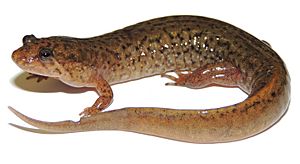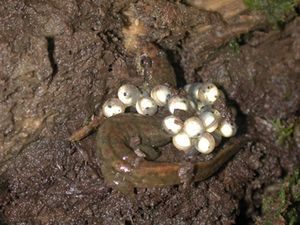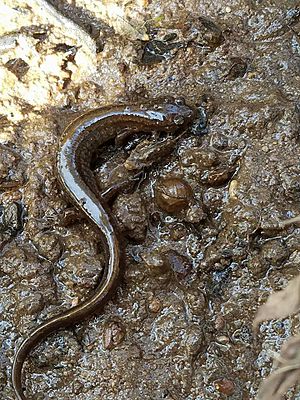Desmognathus fuscus facts for kids
Quick facts for kids Desmognathus fuscus |
|
|---|---|
 |
|
| Conservation status | |
| Scientific classification | |
| Synonyms | |
|
The Desmognathus fuscus is a type of amphibian known as the dusky salamander or northern dusky salamander. It belongs to a group called lungless salamanders. This means it doesn't have lungs! Instead, it breathes through its skin and mouth.
You can find this salamander in eastern North America. It lives from eastern Canada all the way south to Florida and west to Louisiana. It's the most common type of dusky salamander in Canada. These salamanders like places where water is flowing, like rocky streams or springs. They hide under leaves, rocks, or in burrows to stay safe.
Female dusky salamanders lay their eggs near water. The young salamanders, called larvae, usually live in the water.
Contents
What the Northern Dusky Salamander Looks Like
This salamander is small but strong. Its upper body can be reddish-brown, gray, or olive green. Its belly is white or gray. It often has dark spots or blotches on its sides.
Young salamanders have five to eight pairs of spots on their backs. Older ones tend to be dark brown or black all over. A special feature of all dusky salamanders is a light stripe. This stripe is outlined in black and goes from their eye to the back of their jaw.
Northern dusky salamanders have 14 grooves on their sides, called costal grooves. Their back legs are bigger than their front legs. Their tail is shaped like a knife and is flat on the sides near its base. The tail is usually lighter than the body and shorter than half the body's length.
Adults can grow up to 14 centimeters (about 5.5 inches) long. Males are typically around 9.4 cm (3.7 inches) and females 8.6 cm (3.4 inches). Since they are lungless, they get oxygen through their skin and the lining of their mouth and throat. They also have a special groove near their nose. This helps them smell and find food or mates.
How to Tell it Apart from Similar Salamanders
The northern dusky salamander can look a lot like the Allegheny Mountain dusky salamander. But the Mountain dusky salamander usually has V-shaped spots on its back. Its tail is also round at the base, not flat. Sometimes, these two types of salamanders can even breed together.
You can also tell the northern dusky salamander apart from other lungless salamanders. These include the eastern red-backed, northern two-lined, and four-toed salamanders. Remember the pale line from its eye to its jaw. Also, northern dusky salamanders have sturdier bodies and longer back legs.
Where the Northern Dusky Salamander Lives
This salamander is native to North America. It lives in central-eastern Canada and the United States. You can find it from southern New Brunswick and Quebec to southern Ontario. It also lives southwest to eastern Ohio, southern Illinois, Mississippi, and eastern Louisiana.
Some groups of them are found in Arkansas, Louisiana, the Carolinas, Georgia, and the Florida Panhandle. About 5% of all northern dusky salamanders live in Canada. In Canada, they usually live in forests near small streams at high elevations.
Where They Like to Live (Habitat)
In the northern parts of their range, northern dusky salamanders live in wet soil. They are often found near springs, seeps, and small streams. These areas are called riparian zones. They prefer places with lots of forest cover. The trees help keep the water cool and full of oxygen. They also keep the ground moist, which is important for the salamanders to survive.
In the southern parts of their range, they can be found in streams in higher areas. They also live in floodplains, muddy spots, and swampy areas.
Behavior and Daily Life
Northern dusky salamanders hide to stay safe from drying out and from predators. They use underground spots, burrows, leaf litter, logs, rocks, and moss for cover. These hiding spots are also important for finding food and laying eggs. Both of these activities happen on land, close to the water.
Because of the risk of drying out and predators, these salamanders are most active in the morning, evening, and early night. Females lay their eggs in hidden, wet spots near streams. They often choose logs, under rocks or moss, or in holes in stream banks.
When they are young larvae, northern dusky salamanders live only in water. They hide in the spaces between rocks in the streambed. In winter, they stay in shallow running water. Adults might stay active all winter if the ground doesn't freeze. They can also hide in underground spots.
Since they are small, northern dusky salamanders spend most of their lives hidden. If a predator catches them, they can drop their tail to escape. But they don't have special chemicals to defend themselves. Their main predators include larger salamanders, birds, fish, snakes, crayfish, and small mammals like rodents.
A northern dusky salamander usually stays within a small area, about 1 to 3.6 square meters (11 to 39 square feet). They move around more in warmer months. In winter, some groups gather in specific areas for their winter hiding spots.
Reproduction and Life Cycle
Northern dusky salamanders don't move around much. Because of this, different groups of them can be genetically unique. They breed on land, usually once a year in spring or fall. They have special courtship dances.
Males have special glands that get bigger when they are ready to breed. The male will rub his snout and glands on the female's snout. The female then usually picks up a packet of sperm, called a spermatophore. Larger females tend to lay more eggs.
Females usually lay between 10 and 30 eggs. They hide them under logs, moss, or rocks near streams where the soil is wet. The number of eggs can vary, from as few as eight to as many as forty-five. The female stays with her eggs for six to ten weeks. This protects them from drying out and from predators.
When the eggs hatch, the larvae are about 1.5 cm (0.6 inches) long and live in the water. They then change, or metamorphose, into semi-terrestrial adults. Young salamanders are 2.8 to 4.4 cm (1.1 to 1.7 inches) long. Their life cycle has two main parts: an aquatic (water) stage that lasts 7 to 16 months, followed by a semi-terrestrial (partly land) adult stage. They become old enough to reproduce at about three to four years old. They can live for 10 to 15 years.

What the Northern Dusky Salamander Eats
The northern dusky salamander eats a variety of foods, depending on what is available. Salamanders in streams are important predators. This is because they are often the most common vertebrates (animals with backbones) in small forest streams. Their total weight can be more than that of fish, birds, or small mammals in these areas.
These salamanders are carnivores, meaning they eat meat. They eat many different kinds of water and land invertebrates (animals without backbones). Young larvae mostly eat water insects. Adult salamanders eat mostly land invertebrates, like insects and earthworms. If there's a lot of food, they prefer bigger, meatier land invertebrates, such as earthworms. The amount of water insects they eat depends on their habitat and how many insects are available at different times of the year.
Conservation Status
How Many Are There?
We don't have exact numbers for how many northern dusky salamanders there are. But we know that the total adult population is more than 100,000. Many groups of them are stable. In Quebec and New Brunswick, they are widespread, but there aren't many in one place. In Ontario, they are rare, with fewer than 250 individuals estimated.
What Threats Do They Face?
Northern dusky salamanders are very sensitive to drying out. They need clean streams to live. So, pollution from cities, factories, or farms can be very bad for them. For example, they disappeared from Acadia National Park in Maine because of heavy metal pollution. Acid rain also harms streams, especially in the southern Appalachian Mountains.
Changes to stream flow or groundwater can also hurt them. This can happen naturally or because of human activities. For example, too much water runoff can make stream banks unstable. Logging, wind farms, and city growth can also reduce water quality and destroy their hiding spots. When streams get filled with silt (fine dirt), the spaces between rocks where salamanders hide, hunt, and lay eggs are lost. This has caused them to disappear from places like Mount Saint-Hilaire National Park in Quebec. If a group relies on just one stream, like the one in Ontario, they are even more at risk. Also, new types of predatory fish, like Brook Trout, can threaten them.
Protecting the Northern Dusky Salamander
The northern dusky salamander is listed as endangered in Ontario. It is also declining in many parts of the United States. However, some populations are stable. The International Union for Conservation of Nature (IUCN) says its global status is "Least Concern," meaning it's not currently at high risk of extinction worldwide.
In Ontario, the northern dusky salamander is protected by law. It's illegal to harm or kill them, and their habitat is protected. A recovery team is working to help both the Allegheny Mountain and Northern Dusky Salamanders in Ontario.
In Quebec and New Brunswick, the population is not considered at risk. But Quebec is thinking about listing it as threatened or vulnerable. It's already protected by a law that stops people from collecting or selling them. Another law protects their environment from harm. In New Brunswick, it's listed as "Sensitive." The New Brunswick Fish and Wildlife Act also protects them.
See also
 In Spanish: Desmognathus fuscus para niños
In Spanish: Desmognathus fuscus para niños



